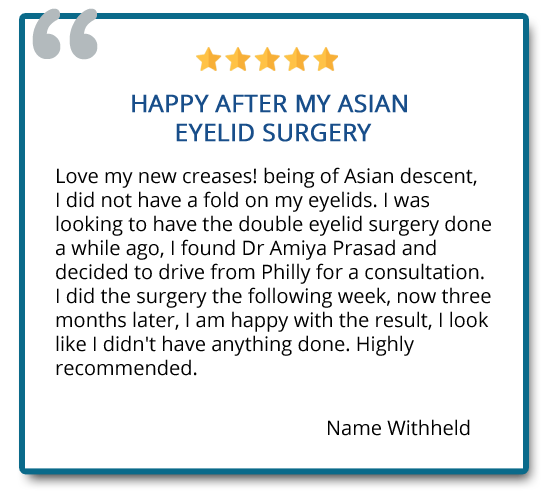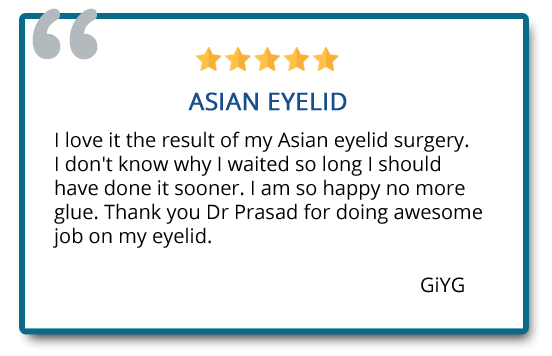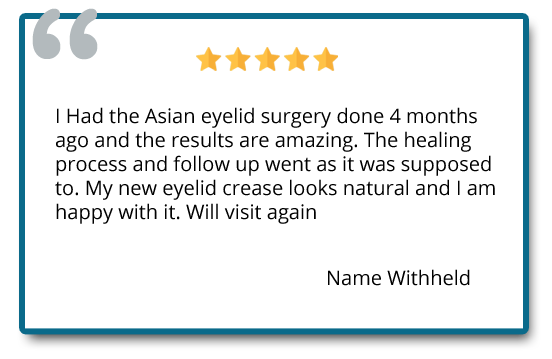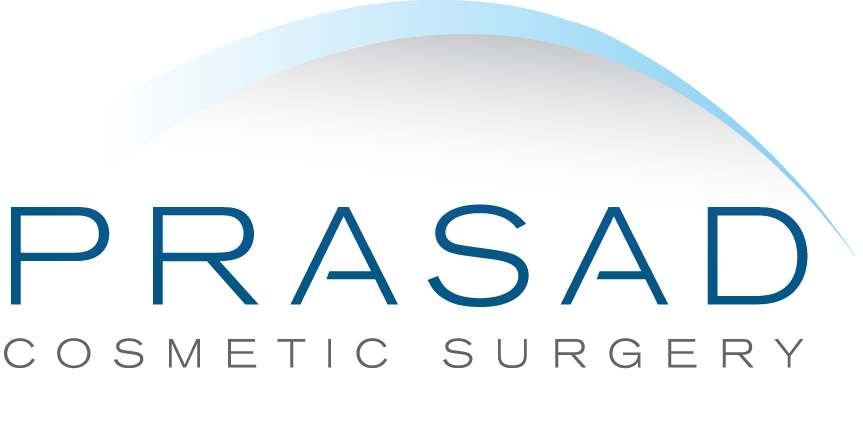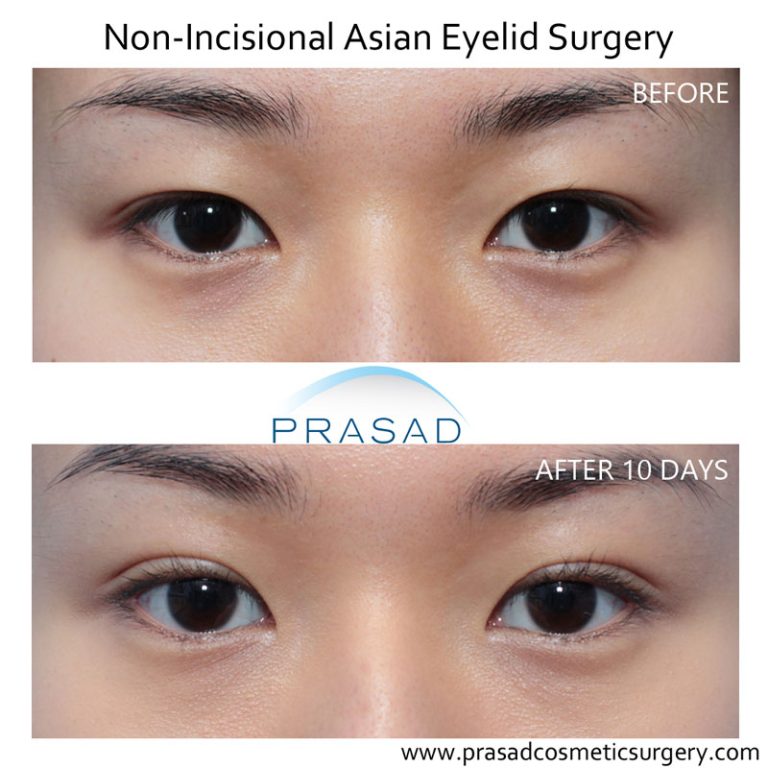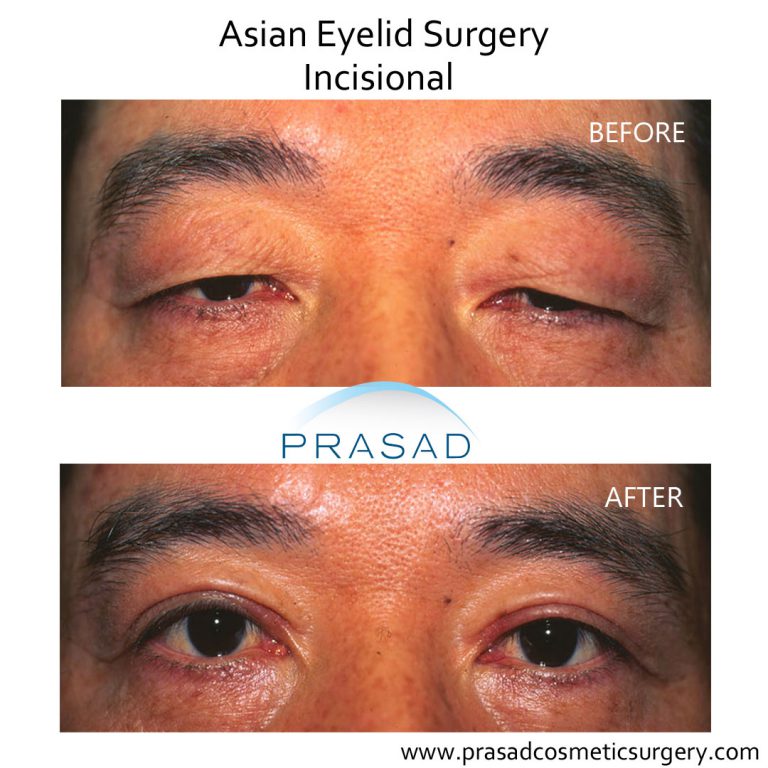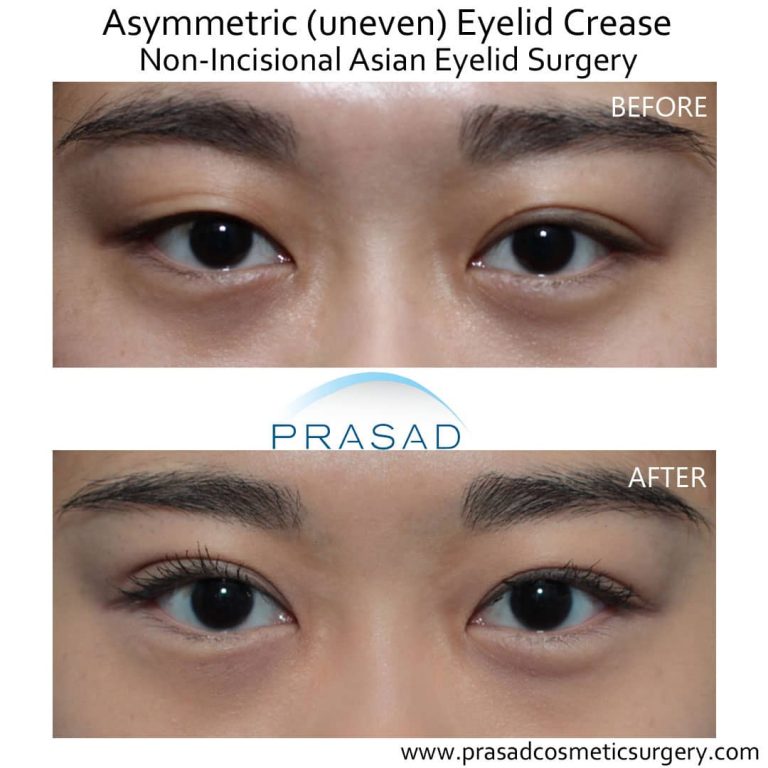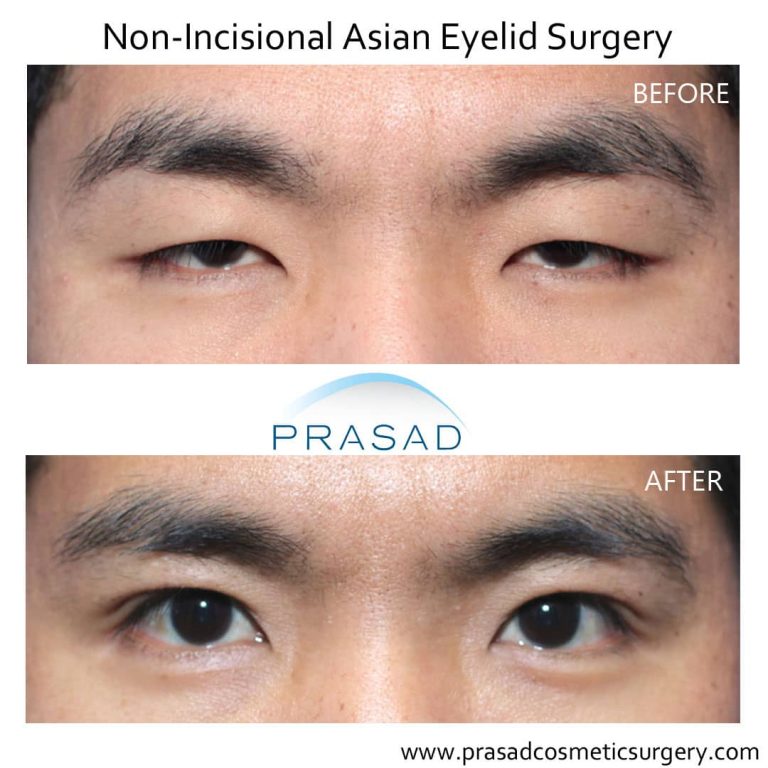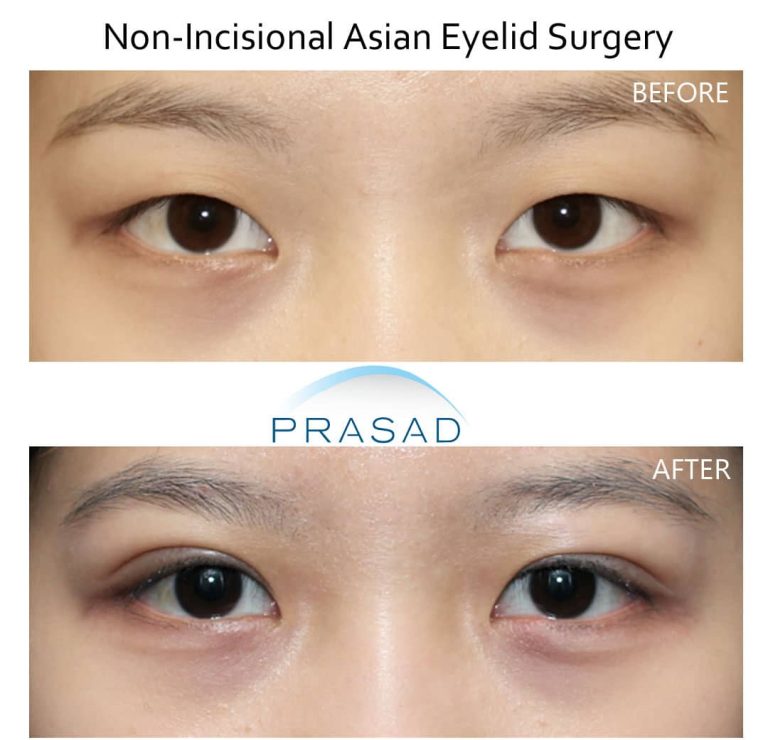Schedule Your Consultation with Dr. Prasad Here
- Home
- About Dr. Prasad
- Face & Eyes
Eyelifts
- Eyelid Surgery
- Eye lift Before and After Photos
- Asian Eyelid Surgery
- Upper Eyelid Surgery
- Upper Eyelid Hollow / Lower Brow Hollowing
- Under Eye Bag Surgery
- Eyelid Ptosis Surgery
- Transconjunctival Blepharoplasty
- Under Eye Fillers
- Eyelid Surgery Revision Specialist
- Thyroid Eye Disease
- Tear Trough Implants
- Eye Lift Questions and Answers
- Body
- Injectables
- Laser
- Hair Restoration
- Photos
- Hair Restoration Before and After Photos
- Eye lift Before and After Photos
- Upper Blepharoplasty Before and After
- Ptosis Surgery Before And After
- Facelift Before and After Photos
- Lip Enhancement Before and After Photos
- Under Eye Filler Before and After
- Blepharoplasty Before and After
- Lower Blepharoplasty Before and After Photos
- Eyelid Surgery Before and After
- Double Eyelid Surgery Before and After
- Contact Us
- Home
- About Dr. Prasad
- Face & Eyes
Eyelifts
- Eyelid Surgery
- Eye lift Before and After Photos
- Asian Eyelid Surgery
- Upper Eyelid Surgery
- Upper Eyelid Hollow / Lower Brow Hollowing
- Under Eye Bag Surgery
- Eyelid Ptosis Surgery
- Transconjunctival Blepharoplasty
- Under Eye Fillers
- Eyelid Surgery Revision Specialist
- Thyroid Eye Disease
- Tear Trough Implants
- Eye Lift Questions and Answers
- Body
- Injectables
- Laser
- Hair Restoration
- Photos
- Hair Restoration Before and After Photos
- Eye lift Before and After Photos
- Upper Blepharoplasty Before and After
- Ptosis Surgery Before And After
- Facelift Before and After Photos
- Lip Enhancement Before and After Photos
- Under Eye Filler Before and After
- Blepharoplasty Before and After
- Lower Blepharoplasty Before and After Photos
- Eyelid Surgery Before and After
- Double Eyelid Surgery Before and After
- Contact Us
Double Eyelid Surgery/ Asian Eyelid Surgery
Natural double eyelids are sometimes hidden behind the eyes. Dr. Prasad helps fold the eyelid crease you’ve always had.
Dr. Prasad brings over 30 years expertise with Asian eyes, from quick healing non-incisional double eyelid surgery, to brighter eyes with incisional double eyelid surgery.
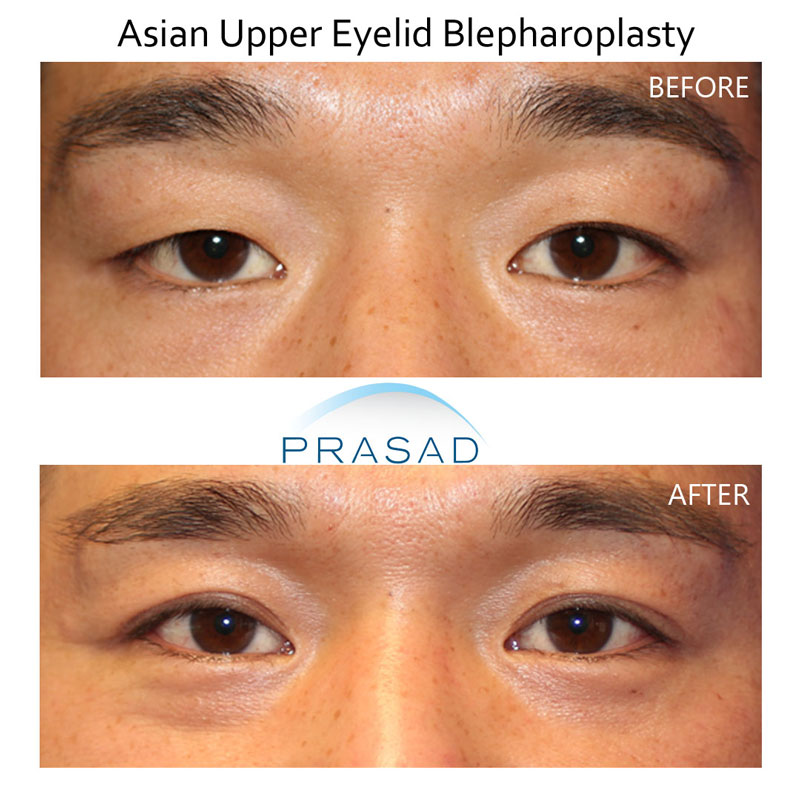
Asian eyes vary in terms of the epicanthal fold, amount of skin, excess fat and other important structural elements. One procedure does not fit all. Oculoplastic surgeon Dr. Prasad has extensive experience with Asian eyelid surgery and has performed double eyelid blepharoplasty for many of his Asian patients from all over the world.
Non-Incisional or Incisional Double Eyelid Surgery?
The incisional, or non-incisional approach to double eyelid surgery are decided based on 2 key anatomic factors:
- Extra fat behind the upper eyelids that prevent the establishment of a defined eyelid crease
- Extra eyelid skin causing hooding, preventing an eyelid crease from being visible
Non-Incisional Double Eyelid Surgery
As fat accumulating behind the eyelid, and eyelid skin being stretched over time are both effects of aging, non-incisional double eyelid surgery is usually performed on younger people.
Non-incisional double eyelid surgery uses small openings in the eyelid skin to pass a suture to connect to the levator muscle that lifts the eyelid.
The upper eyelid folds where the suture connection is made, creating a stable double eyelid crease. It is called the non-incisional technique because there is no incision on the eyelid skin to excise excess fat, or to trim excess eyelid skin. The lack of an incision, and removal of excess skin and fat also make recovery from non-incisonal double eyelid surgery faster.
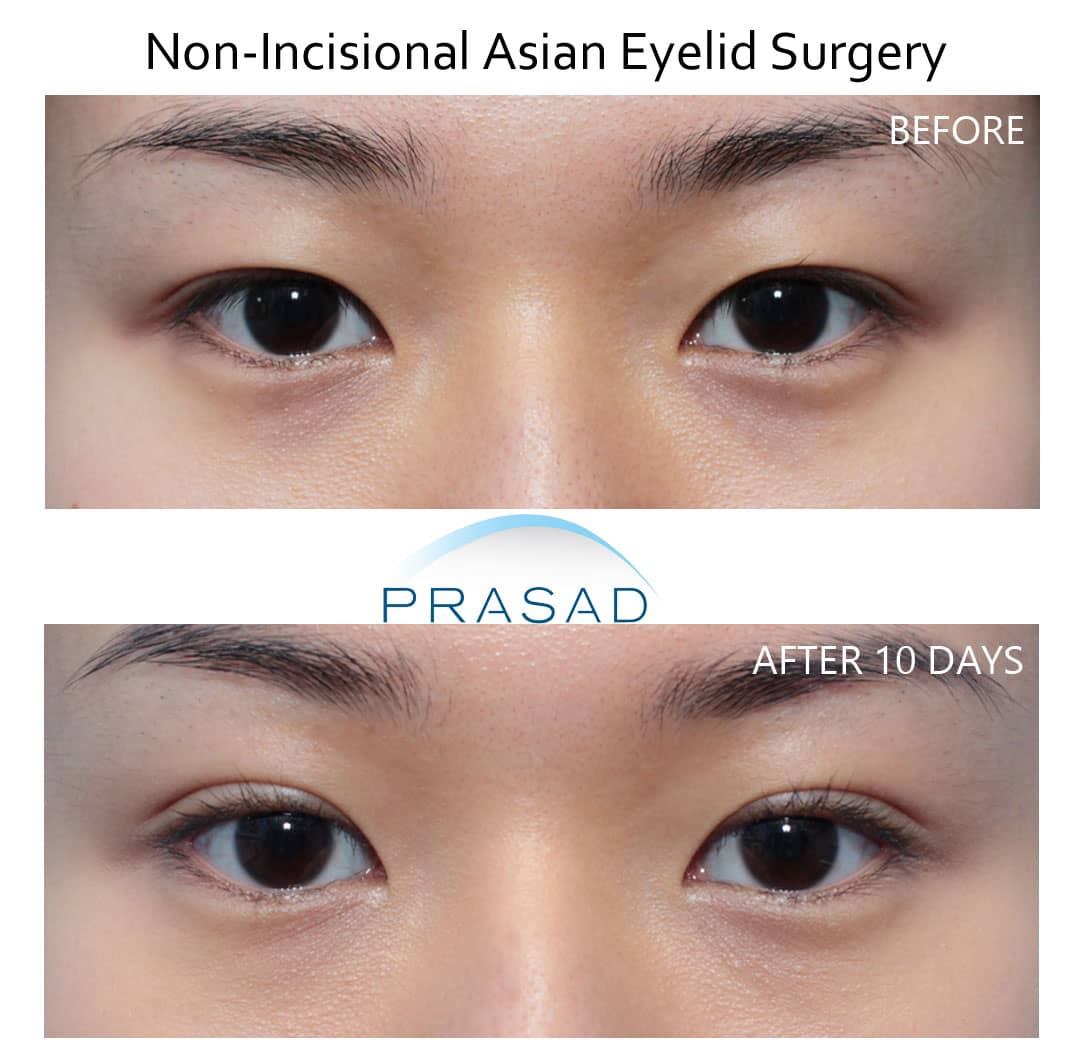
Incisional Asian Double Eyelid Surgery
Incisional double eyelid surgery is performed when there is excess eyelid skin causing hooding or obscuring an eyelid crease, and/or excess fat behind the eyelid prevents a connection being made from the eyelid skin, to the levator muscle that lifts the eyelid. Careful planning is needed to measure excess eyelid skin so there isn’t a skin shortage after surgery. The incisional technique is usually used on older people who have stretched upper eyelid skin, and accumulated orbital fat behind the eyelid due to aging.
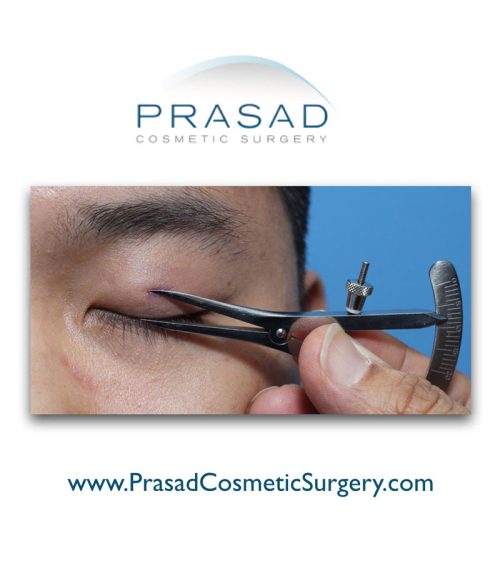
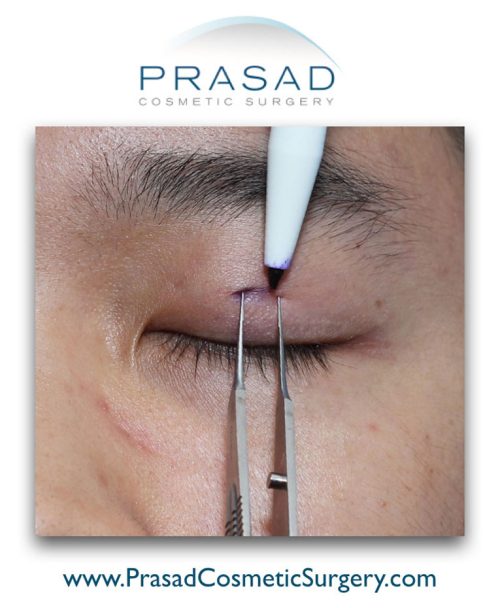

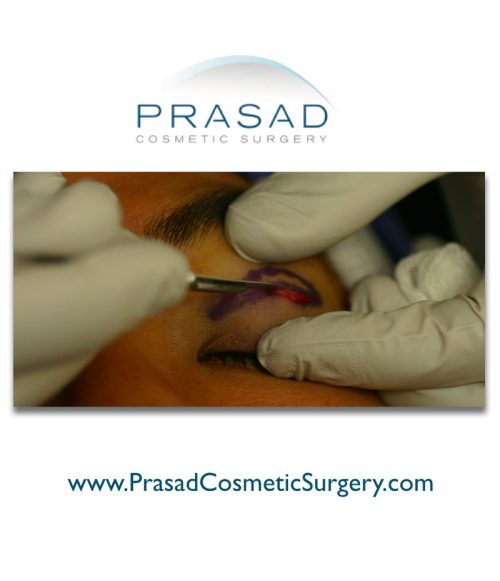
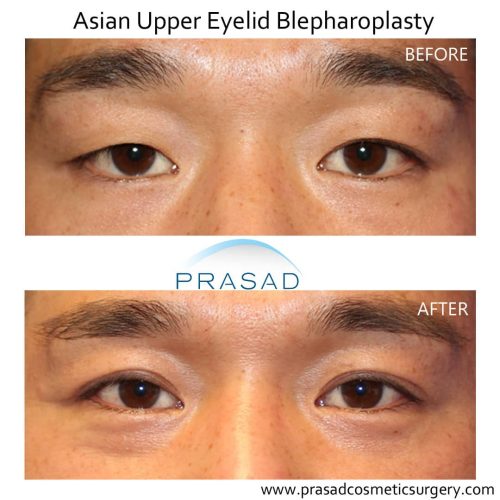
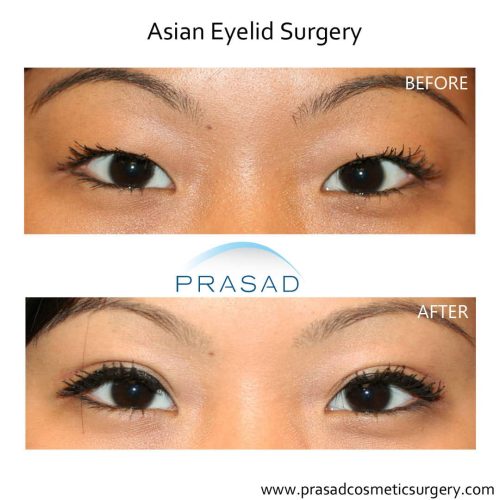
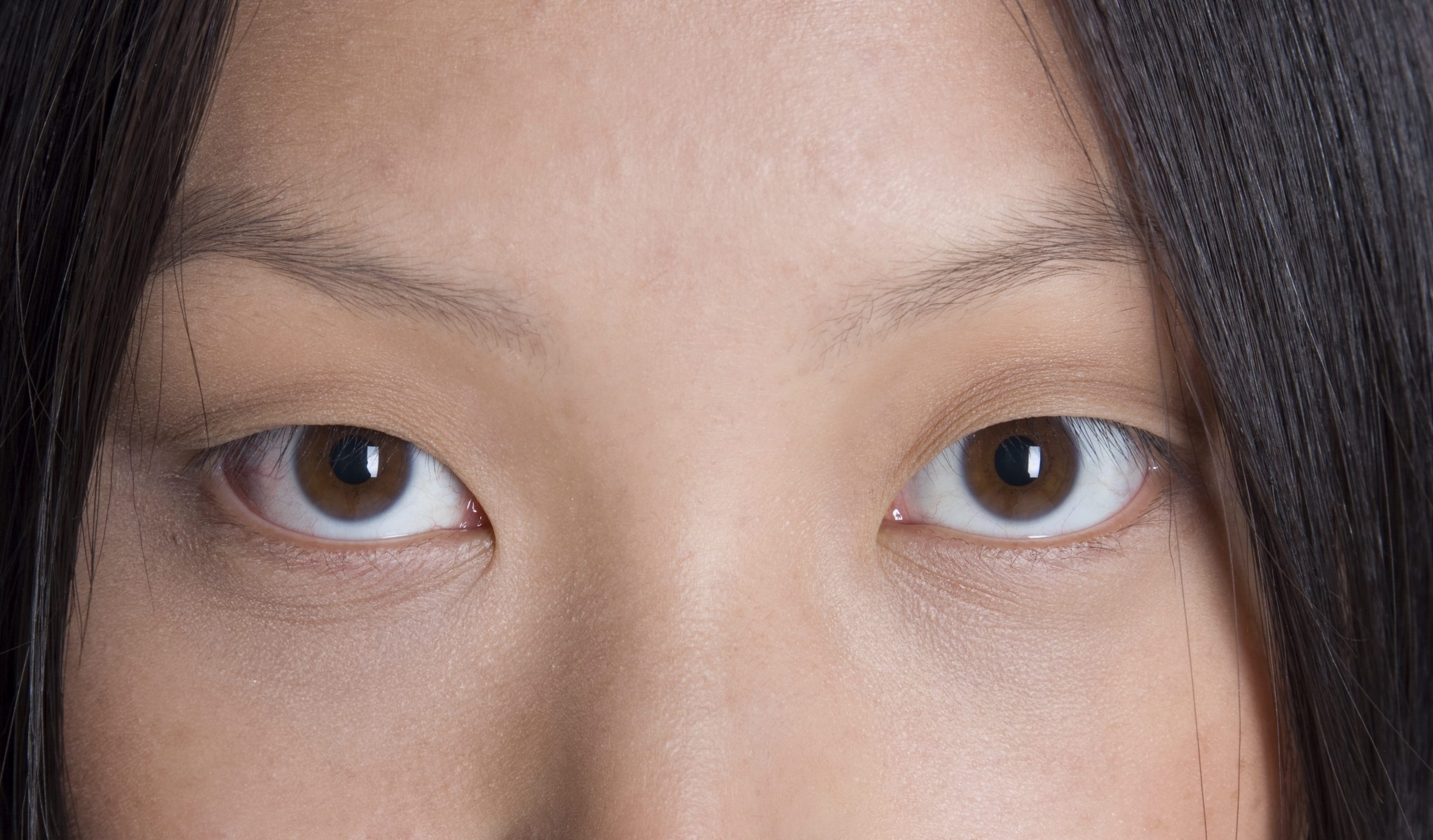
What can go wrong with double eyelid surgery?
One of the most frequent errors made by plastic surgeons performing Asian eyelid surgery results in “Europeanizing” the eyelids, which results in a very unnatural appearance. The Asian eyelid is different from the Caucasian eyelid in many ways, which is why Asian eyelid surgery (blepharoplasty) is so unique. It is important to know that Asians do not only have one type of eyelid.
Why is double eyelid surgery popular?
Among the 50% of Asians having an eyelid crease there can be variability as to the symmetry and definition of the eyelid creases. Some people report that the crease can change where one day they have a crease and the next day the crease is not as defined. Many Asian patients come to address their desire to have a stable and single crease to enhance the appearance of their eyes.
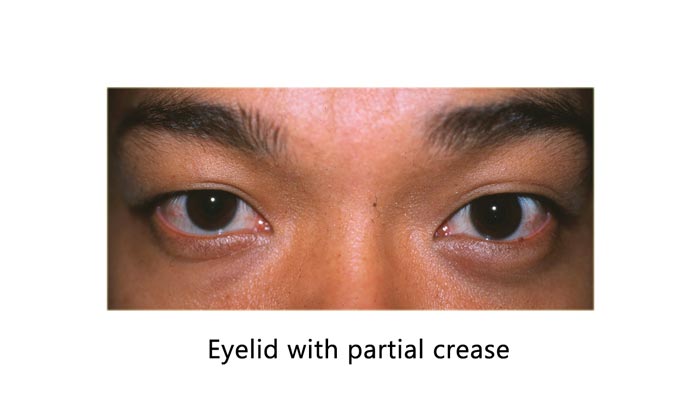
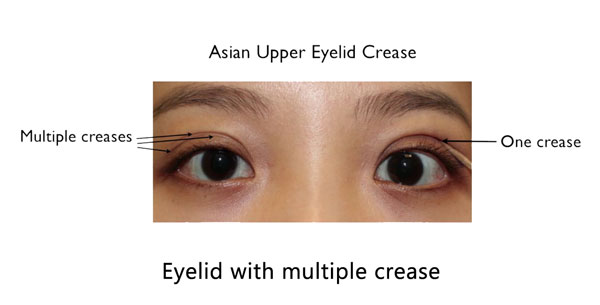
The position of the fold to be created varies from patient to patient, Dr Prasad will show you where the fold can be placed to achieve a natural look. Depending on your anatomy, the fold can be positioned 2-3 mm above the lid (fine crease), 4-6 mm(medium crease) or 7-10 mm( deep crease).
This is a function of the amount of skin which overlaps the position of the actual crease which can vary from 6.5 to 10 mm. In contrast, blepharoplasty (eyelid lift) in Caucasians is generally performed to reveal more of the eyelid and can be 10 mm or higher.
Types of Eyelid Creases
Asian eyes have a natural tendency to have an eyelid crease, even in people born without double eyelid folds. A person’s individual anatomy determines whether their crease is parallel, or tapers into the inner corner of the eye.
Asian Blepharoplasty for Multiple/ Undefined Eyelid Creases
Some people are born with multiple, but shallow eyelid creases, or an undefined crease, which are due to a weak fibrous connection between the eyelid skin, and the levator muscle. Double eyelid surgery can strengthen the fibrous connection using sutures, creating a deep, and defined eyelid crease.
Am I a candidate for double eyelid surgery?
If you’re someone who wants to have a more defined eyelid crease, you may be a candidate. It’s important to understand that age can be a factor in the type of crease and the method of surgery required. For example, a 60-year-old woman would likely need a different type of surgery when compared to a 30-year-old man.
How to Prepare for Asian Eyelid Surgery
As with most cosmetic surgeries, it’s important that you be in good health. Management of conditions such as blood pressure and diabetes are also important. Prior to surgery, we routinely review current medications and make sure our patients avoid any medication or supplement that is a blood thinner. During your consultation, Dr. Prasad will guide you in preparing for your procedure.
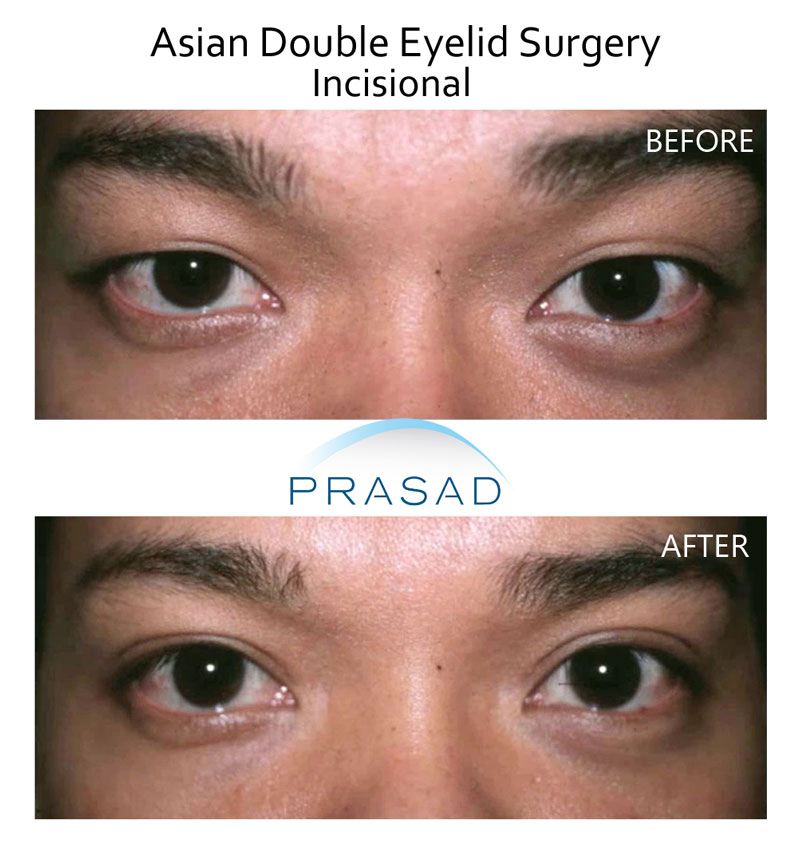
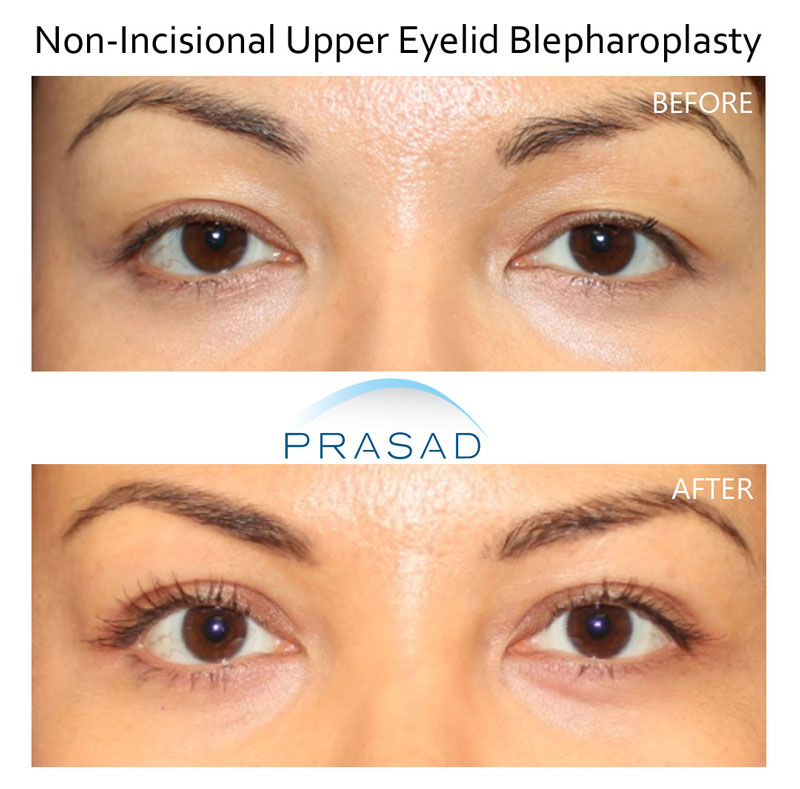
Your Double Eyelid Surgery Journey with Dr. Prasad
Asian eyelid surgery consists of reshaping the upper eyelid. During your consultation with Dr. Prasad, various factors will be evaluated including:
- Your skin thickness and quality
- Your fat volume under the skin
- Your healing from past procedures
- Your unique anatomy around your eyes
- Your age
- Your gender
Dr. Amiya Prasad will customize the procedure to create the fold. Depending on the amount of extra skin and fat under the upper eyelid, Dr. Prasad will choose to perform a non-incisional or an incisional procedure.
Technically, the non-incisional technique is still surgery, but instead of making an incision and removing skin from the upper eyelid, small openings are made in the skin. A stitch is passed through in a way to attach the upper eyelid skin to the underlying levator muscle muscle, which is responsible for lifting the eyelid. This will result in the eyelid skin folding in when the eyes are opened.
If there is extra skin and fat on the upper eyelid, an incisional approach is used to create the fold. After Dr. Prasad draws the appropriate pattern, an incision will be made in the upper eyelid area. Typically, a small volume of fat will be removed in order for the crease to be defined with the intention of avoiding creating a “hollow” area.
Asian Eyelid Surgery Recovery & Follow Up
Following your double eyelid surgery, you will be seen in about 1 week for removal of sutures (for incisional surgery). Swelling after Asian eyelid surgery is common and can make the eyelid crease appear too high. You will see Dr. Prasad regularly after your procedure to make sure you are healing properly.
The healing process for an Asian eyelid surgery can appear to be longer than non Asian patient. Swelling between the eyelid crease and the eyelid margin can persist for months and even a year.
Factors which can affect the recovery process include allergies, sinus conditions as well as having sensitive skin. Dr. Prasad will see you throughout your recovery period to assist you during this time.
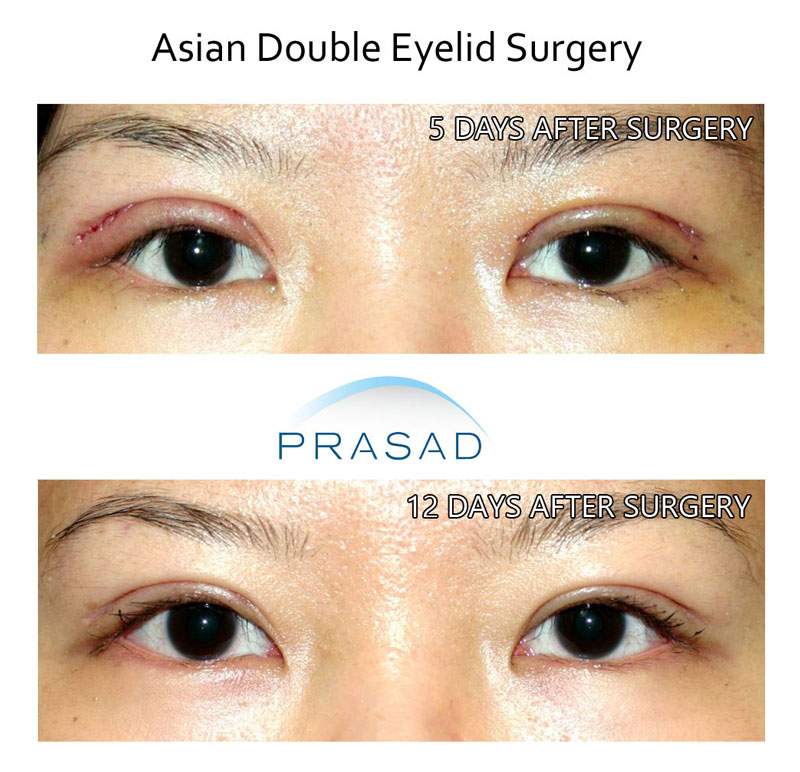
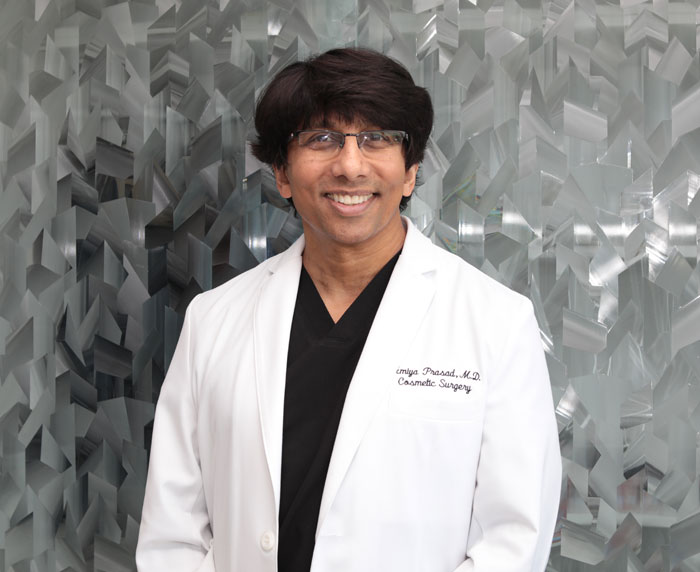
Why Choose Dr. Prasad for Double Eyelid Surgery in New York?
With over three decades of specialized experience in oculofacial plastic surgery, Dr. Amiya Prasad hasa focused understanding of Asian eyelid anatomy, and the nuance of Asian double eyelid surgery. He has successfully performed double eyelid blepharoplasty for patients of different origins, coming from around the world.
- Specialized Expertise: Dr. Prasad’s precision in cosmetic eyelid surgery ensures a deep understanding of complex eyelid aesthetics.
- Natural-Looking Results: His philosophy centers on enhancing your natural beauty, avoiding any unnatural appearance.
- Customized Approach: Every procedure is tailored to your unique anatomy and desired outcome.
- Comprehensive Care: From consultation, to follow-up, you receive dedicated support during surgery, and recovery
- State-of-the-Art Facilities: Dr. Prasad performs procedures at his state-of-the-art surgical facilities, committed to the safest surgical practices.
Double Eyelid Surgery NYC and Long Island, New York
If you are considering Asian/double eyelid surgery you can fill up our contact form or call any of our offices:
- Midtown Manhattan, New York City Office: (212) 265-8877
- Garden City, Long Island Office: (516) 742-4636
- Vienna, Virginia Office: (703) 356-1336 / (703) 821-2683
Schedule your consultation with Dr. Prasad today to discuss your aesthetic goals.
Frequently Asked Questions (FAQs) About Double Eyelid Surgery
How much is double eyelid surgery?
Double eyelid surgery or Asian blepharoplasty is a customized procedure. The cost varies depending on the individual patient’s needs and if it’s combined with other procedures. Costs include the surgeon’s fee, anesthesia fee, and facility fees. Dr. Prasad is committed to performing surgery in the safest way at his state-of-the-art surgical facilities. We can provide a detailed estimate during your personal consultation.
Does double eyelid surgery make your eyes bigger?
Yes, one of the primary objectives of double eyelid surgery is to make the eyes look bigger and more open, which adds a look of vibrancy and vitality to the whole face. Dr. Prasad achieves this by revealing the true shape and intrinsic beauty of Asian eyes.
How long does double eyelid surgery last?
The results of double eyelid surgery can last 5-10 years, or even longer. There are factors that determine the longevity of results, such as age at the time of surgery. The results of a patient in their 30s will last longer than a patient who had their surgery in their 50s because aging factors, like eyelid skin stretching, and fat accumulation behind the eyelid, would be slower for a younger patient than an older one.
How long does double eyelid surgery take?
In most cases, the surgical portion of double eyelid surgery takes approximately 1 hour. However, factoring in preparation time and immediate post-operative recovery, you’ll typically be at the clinic for about 3 hours. If combined with other procedures, the surgery time may be longer.
How long does double eyelid surgery take to heal?
The healing time for your double eyelid crease to fully form varies depending on the extent of surgery and the specific technique used. Our patients generally return to work after one week. Swelling or inflammation after Asian eyelid surgery is normal during the post-operative period and gradually subsides.
Is double eyelid surgery painful?
You will experience no pain or discomfort during the double eyelid surgery procedure, as it’s performed under local anesthesia with LITE™ IV sedation. Our patients often report feeling wide awake and rested when they wake up. During surgery, Dr. Prasad may ask you to open your eyes (you will feel nothing) to ensure the eyelid crease forms perfectly, usually while sitting up under normal gravity.
Do you get anesthesia for double eyelid surgery?
Yes, the procedure is performed under local anesthesia with intravenous (IV) sedation, specifically LITE™ IV sedation. Our patients consistently appreciate being able to avoid general anesthesia while remaining comfortable throughout the procedure.
Patient Reviews
